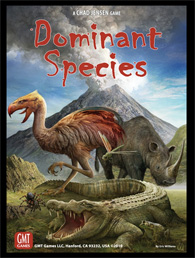



play board games
Board game reviews, strategy tips & session reports
Dominant Species Review
 Stats:
Stats:
No. of players: 2-6
Amount of time to play: 2-4 hours
Age requirements: 12+
Set-up time: 10 minutes
Dominant Species Rules Description:
Dominant Species is a highly strategic area control game. You try to make your animal the dominant species by scoring the most points. This game combines many mechanics common to Eurogames to help you score those points.
To start the game you’ll get an animal. Each animal has different elements on its card which help you determine tile dominance. They also have a unique power they may use once per turn.
The two key ways to score are by having the most cubes on a tile or by having dominance on a tile. In order to claim dominance of a tile your animal card must match the most number of elements on that tile. Elements are placed at the corner of each hex that makes up the map. They may change or be removed based on the actions players take. So dominance of a tile can change throughout the game or even in the middle of a turn.
Dominant Species consists of three phases: planning, execution and reset. During planning you’ll place your Action Pawns (APs) in spots that denote specific actions. After all APs have been placed you then go down the action track from top to bottom and left to right.
The actions you may select are Initiative, Adaptation, Regression, Abundance, Wasteland, Depletion, Glaciation, Speciation, Wanderlust, Migration, Competition and Domination.
Initiative allows you to move forward in the turn order. The other nice thing is you get to place this pawn again.
Adaptation will add elements to your animal card. This will allow your animal to survive in more places or might help them dominate a tile.
Regression will take elements off players’ animal card. If you have an AP here you may take one of these elements before they are removed form your animal card.
Abundance adds elements to the hexes on the board. Similar to Adaptation but will effect the board.
Wasteland removes any elements in this box from the board that are next to a glacier. If you have an AP here you may remove one element to protect it from being removed from the board.
Depletion allows one player to remove the elements in this box from anywhere on the board.
Glaciation adds a Tundra tile to the board. This will score you points and remove all but one cube of each color from that tile.
Speciation adds cubes to the board. You must pick one element and add species based on the terrain of the hexes you are adding cubes to.
Wanderlust adds a hex to the map. Again this will score you points based on the number of other tiles this is placed next to. You also take an element from this box and add it to the hex when it is placed.
Migration allows you to move cubes on the board.
Competition allows you to remove one cube from any tile that you have a cube on.
Domination lets you score one tile that has not been scored this turn. Tiles are scored based on the terrain type. Certain terrain will score first, second and even third or fourth place. You then let the dominant animal take a Domination Card and execute its action. These cards tend to be powerful.
The Reset phase starts by checking to see if any animals go extinct. If you have cubes on a tile that has no elements that match your animal card, those species die and the cubes are removed from the board.
You then score for survival. If you have the most cubes on the Tundra tiles you will score based on the number of tiles you are on.
Next you reseed the board by moving elements and adding elements onto spaces that need them.
Once the Ice Age Domination card is taken the game is over at the end of that turn. The last thing you do after checking for survival again is score each tile one last time. If you have the most points you are the winner.
A Quick Review of Dominant Species:
Some call Dominant Species a brain burner. And in a lot of ways it is. You’ll need to think ahead and plan some moves a turn or two in advance while other decisions are made when the right opportunity arises. This balance between planning and spontaneity is important.
As I said this game combines many common mechanics including: area control, worker placement, tile placement, and variable player powers. Combined together they make for a fairly complex game.
There are a lot of things to keep track of and you’ll probably misplace a few APs the first time you play. That said, after a few plays you should have a handle on what actions do what. But you still may have trouble knowing where to place your APs. Dominant Species is a long game and will be longer if you play with someone that suffers from analysis paralysis.
You may not enjoy Dominant Species if you dislike mean games with cut-throat tactics. Not all actions in the game are mean, but you will probably have a problem being competitive if you are unwilling to give someone the shaft.
The art for this game is excellent and the components are well-made. The theme is strong. You can imagine slowly growing your species or having one animal kill another. The rulebook is fantastic and even though the game is complex the rules are straightforward and easy to understand with many well-illustrated examples.
Dominant Species may not be for everyone as its complexity will scare some away. But if you are an experienced gamer than you should enjoy this game. Especially if you like worker placement or area control games. This was one of the best games released in 2010 and I’d highly encourage purchasing it. The only reason I rated it a 5 instead of a 6 is the game length and the complexity. These two factors will keep it off my table more than I’d like.
Score and synopsis: (Click here for an explanation of these review categories.)
Strategy 5 out of 6
Luck 2 out of 6
Player Interaction 6 out of 6
Replay Value 4 out of 6
Complexity 6 out of 6
Fun 5 out of 6
Overall 5 out of 6

One thing I like about this one is the variable player powers; I’ve tried three of the species so far and am looking forward to trying the other three. Can be a pain to get enough people together for a game, though.